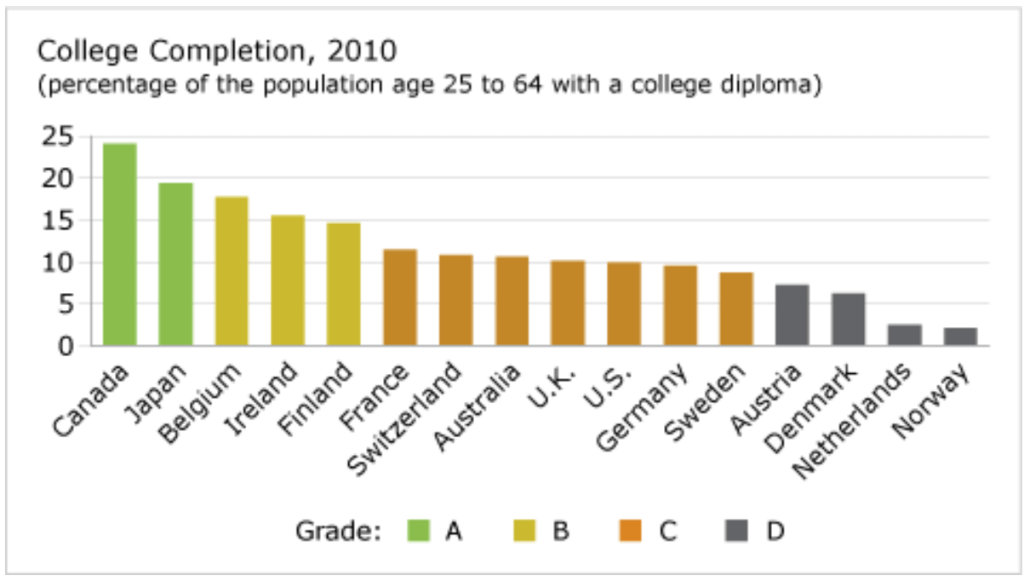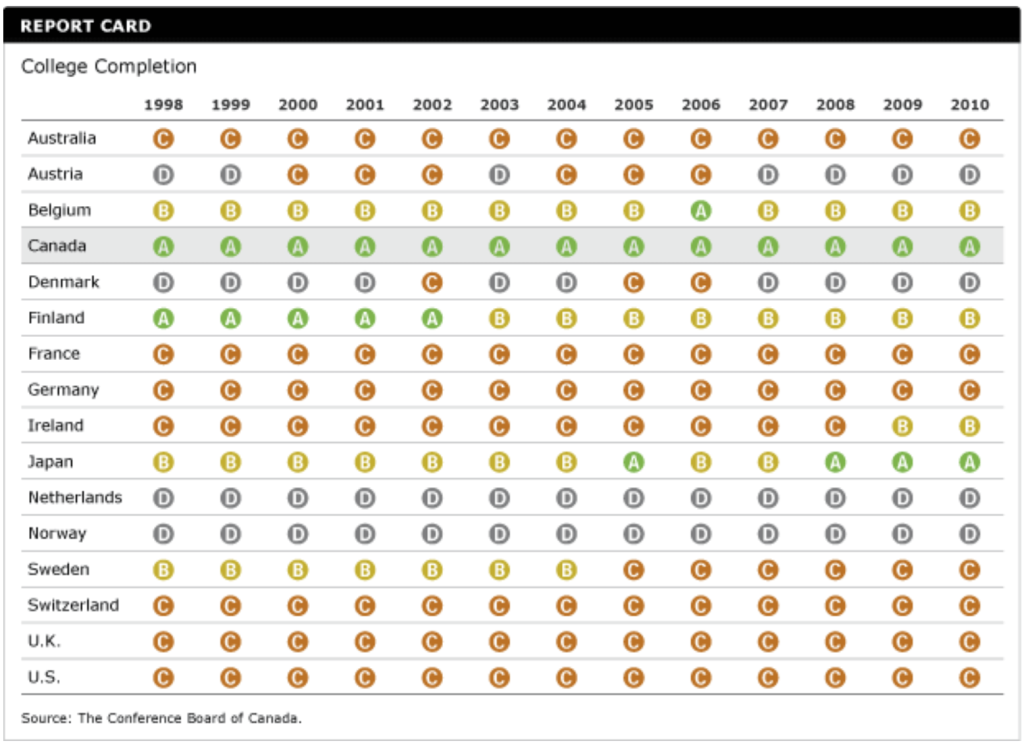College Completion
Key Messages
- Canada gets an “A” grade and ranks 1st out of 16 peer countries.
- Canada is the only peer country to obtain an “A” grade every year since 1998.
- Quebec’s CEGEP system accounts for a large proportion of college enrolment in Canada.

Putting college completion into context
Governments have plenty of evidence that well-educated citizens are more actively engaged in society: they tend to make better choices about factors that affect their quality of life (e.g., diet, smoking, exercise); and they earn higher incomes than those who are less educated. Less prominent in the mind of the public, but equally well-known among decision-makers, is the fact that well-educated and skilled people make important contributions to business innovation, productivity, and national economic performance. In an interconnected global economy, countries with more highly skilled workers have a distinct competitive advantage.
How does Canada’s college graduation rate compare to that of its peer countries?
Canada has the highest rate of college completion among its peer countries. Canada has consistently performed at the top level on college completion. All competitor countries except Belgium, Finland, Ireland, and Japan have college completion rates that are more than 10 percentage points lower than Canada’s.
Has Canada’s college completion rate increased over time?
By consistently performing well on college completion rates, Canada has established a sizable gap between its performance and those of its peer countries. Canada’s college completion rate increased from 19.9 per cent in 1998 to 24.2 per cent in 2010, garnering “A” grades each year, the only peer country to achieve this.

One reason for Canada’s high ranking on college completion is the unique role of colleges known as CEGEPs (collèges d’enseignement général et professionnel) in Canada’s second-largest province, Quebec. CEGEP is a pre-university program offered after Grade 11 that replaces the extra year of high school provided in other Canadian provinces. As a two-year program, however, it also covers one year of community college. It is a prerequisite for university acceptance. CEGEP enrolment is around 150,000 per year. Between 1990 and 2006, college participation rates for those aged 17 to 19 were consistently above 35 per cent in Quebec, compared with only 10 per cent in the rest of Canada.
The CEGEP system was started in 1967 by Quebec’s provincial government. The goal was to make post-secondary education more accessible by preparing student to enter university or a technical profession. The government has also used CEGEP to encourage public-private partnerships in technology transfer. Many CEGEPs have set up “technology transfer centres” where applied research is carried out in a specific field in cooperation with industrial partners in key sectors of the Quebec economy.
Is a university degree better than a college diploma?
It has long been argued, based on income data, that university completion is the most relevant indicator of Canada’s ability to produce highly talented, innovative people. The “returns on education” data support this argument, since university graduates, as a group, earn more, on average, than college graduates do.
However, recent research suggests the field of study may be more important than the type of academic institution attended. One study, for example, found that males with university degrees in academic disciplines—such as the humanities, education, biology, and agriculture science—earned less than half of that earned by males with university degrees in vocational and applied disciplines—such as commerce, medicine, and engineering.1 Another study identified similar differences in earnings for college disciplines in Canada and found that these discrepancies drove enrolments toward disciplines with higher earnings expectations.2 Perhaps the distinction between college and university is less important than the relevance of the discipline to the workplace, since it is relevance—along with supply and demand—that sets the market price for skilled talent.
Footnotes
1 Alan Stark, Which Fields Pay, Which Fields Don’t? An Examination of the Returns to University Education in Canada by Detailed Field of Study (Ottawa: Department of Finance Canada, February 2007).
2 Brahim Boudarbat, Earnings and Community College Field of Study Choice in Canada, Discussion paper (Bonn: Institute for the Study of Labour, May 2004).

